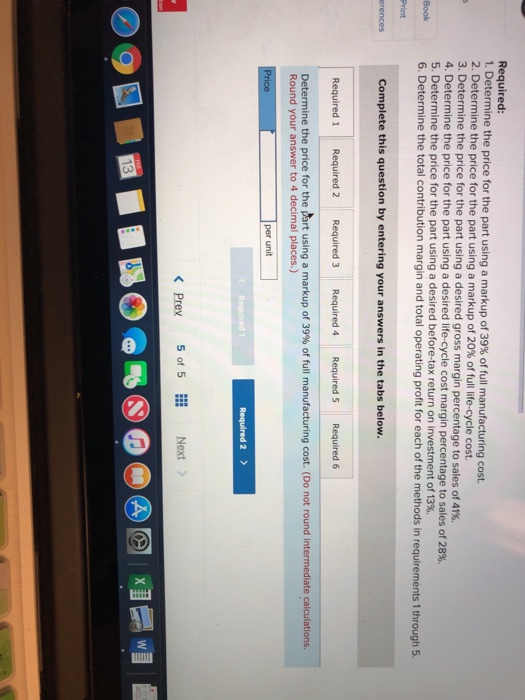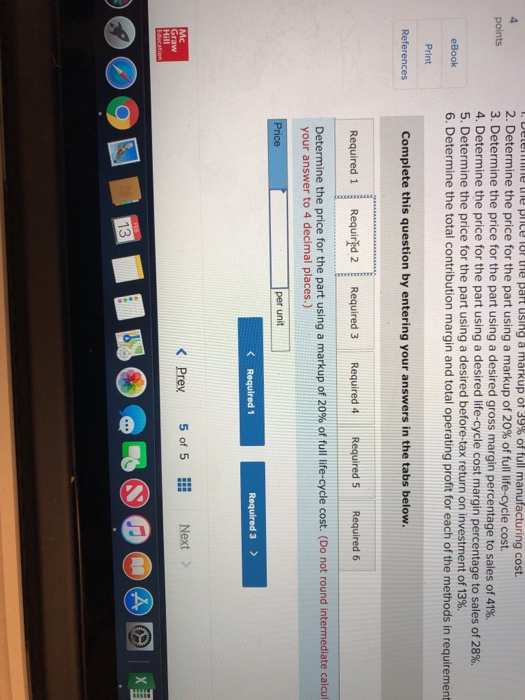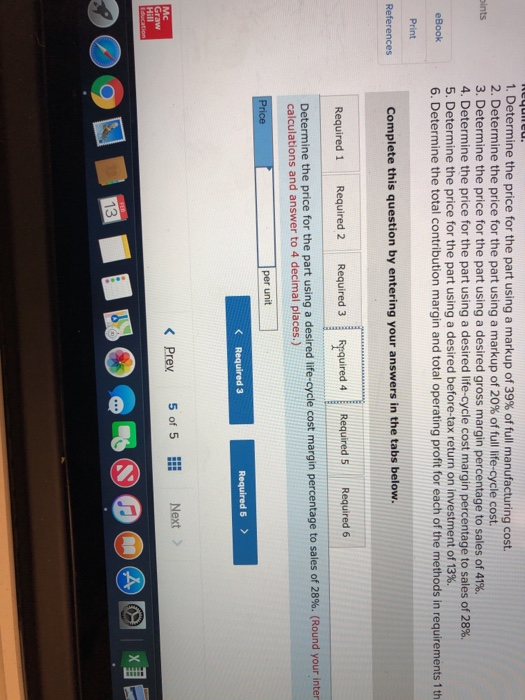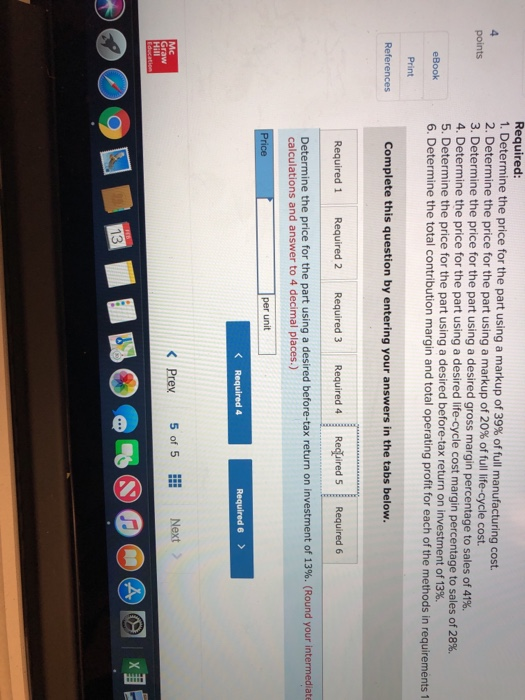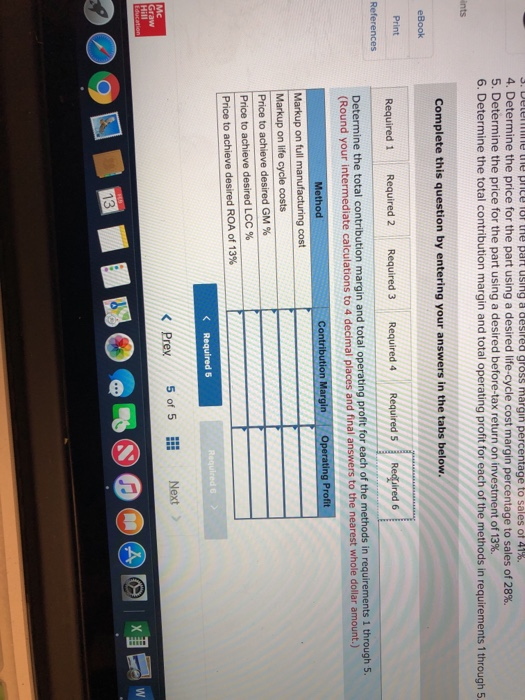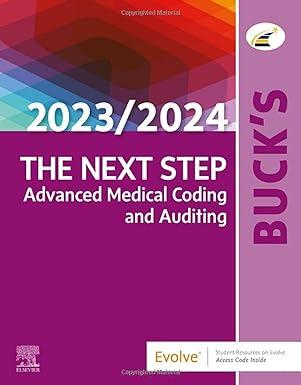Check my work liams Inc. produces a single product, a part used in the manufacture of automobile transmissions. Known for its quality and formance, the part is sold to luxury auto manufacturers around the world. Because this is a quality product, Williams has some flexibility in pricing the part. The firm calculates the price using a variety of pricing methods and then chooses the final price based on that information and other strategic information. A summary of the key cost information follows. Williams expects to manufacture and sell 58,500 parts in the coming year. While the demand for Williams's part has been growing in the past 2 years, anagement is not only aware of the cyclical nature of the automobile industry, but also concerned about market share profits during the industry's current downturn nt Variable manufacturing Variable selling and administrative Facility-level fixed overhead Fixed selling and administrative Batch-level fixed overhead Total investment in product line Expected sales (units 4,663,000 838, 650 2,328,875 658,495 343,000 22,333,000 58,500 I. Determine the price for the part using a markup of 39% of full manufacturing cost. 2, Determine the price for the part using a markup of 20% of full life-cycle cost. 3, Determine the price for the part using a desired gross margin percentage to sales of 41% 4. Determine the price for the part using a desired life-cycle cost margin percentage to sales 5. Determine the price for the part using a desired before-tax return on investment of 13% 6. Determine the total contribution margin and total operating profit for each of the methods in requirements 1 through 5 Required: I. Determine the price for the part using a markup of 39% of full manufacturing cost. 2, Determine the price for the part using a markup of 20% of full life-cycle cost. 3, Determine the price for the part using a desired gross margin percentage to sales of 41%. 4. Determine the price for the part using a desired life-cycle cost margin percentage to sales of 28%. 5. Determine the price for the part using a desired before-tax return on investment of 13%. 6. Determine the total contribution margin and total operating profit for each of the methods in requirements 1 through5. Complete this question by entering your answers in the tabs below Required 1 Required 2 Required 3 Required 4 Required S Required 6 Determine the price for the Art using a markup of 39% of full manufacturing cost. (Do not round intermediate calculations. Round your answer to 4 decimal places) per unit ce KPre 5 of 5Next termine the price or the part using a markup of 39% of full manufacturing cost. 2. Determine the price for the part using a markup of 20% of full life-cycle cost. 3, Determine the price for the part using a desired gross margin percentage to sales of 41%. 4. Determine the price for the part using a desired life-cycle cost margin percentage to sales of 28%. 5. Determine the price for the part using a desired before-tax return on investment of 13%. 6. Determine the total contribution margin and total operating profit for each of the methods in requirement points eBook Print References Complete this question by entering your answers in the tabs below. Required1 Requird2Required 3 Required 4 Required 5 Required 6 Determine the price for the part using a markup of 20% of full life-cycle cost. (Do not round intermediate calcul your answer to 4 decimal places.) per unit KRequired 1 Required 3> Mc Hill I. Determine the price for the part using a markup of 39% of full manufacturing cost. 2, Determine the price for the part using a markup of 20% of full life-cycle cost. 3, Determine the price for the part using a desired gross margin percentage to sales of 41%. 4. Determine the price for the part using a desired life-cycle cost margin percentage to sales of 28%. 5. Determine the price for the part using a desired before-tax return on investment of 13%. 6. Determine the total contribution margin and total operating profit for each of the methods in requirements 1 through ts Print Complete this question by entering your answers in the tabs below. Required 1 Required 2 Requted 3 Required 4 Required 5 Required 6 Determine the price for the part using a desired gross margin percentage to sales of 41%. (Round your intermediate calculations and answer to 4 decimal places.) KPrev 5 of 5 Next I. Determine the price for the part using a markup of 39% of full manufacturing cost. 2, Determine the price for the part using a markup of 20% of full life-cycle cost. 3. Determine the price for the part using a desired gross margin percentage to sales of 41%. 4. Determine the price for the part using a desired life-cycle cost margin percentage to sales of 28%. 5. Determine the price for the part using a desired before-tax return on investment of 13%. 6. Determine the total contribution margin and total operating profit for each of the methods in requirements 1 th ints eBook Print References Complete this question by entering your answers in the tabs below. Required 1 Required 2 Required 3 Requ Determine the price for the part using a desired life-cycle cost margin percentage to sales of 28%. (Round your inter calculations and answer to 4 decimal places.) per unit KRequired 3 Required 5> K Prev5 of 5 Next> Hill Required: I. Determine the price for the part using a markup of 39% of full manufacturing cost. 2, Determine the price for the part using a markup of 20% of full life-cycle cost. 3, Determine the price for the part using a desired gross margin percentage to sales of 41% 4. Determine the price for the part using a desired life-cycle cost margin percentage to sales of 28%. 5. Determine the price for the part using a desired before-tax return on investment of 13%. 6. Determine the total contribution margin and total operating profit for each of the methods in requirements 1 4 points eBook Print References Complete this question by entering your answers in the tabs below. equired Required 2 Required 3 Required 4 Recyired 5 Required 6 Determine the price for the part using a desired before-tax return on investment of 13%. (Round your intermediate calculations and answer to 4 decimal places.) per unit K Required 4 3 J. Detellllllle ule pnce or the part using a desired gross margin percentage to sales of 41%. Determine the price for the part using a desired life-cycle cost margin percentage to sales of 28%. 5. Determine the price for the part using a desired before-tax return on investment of 13%. 6. Determine the total contribution margin and total operating profit for each of the methods in requirements 1 through 5 ints Complete this question by entering your answers in the tabs below Print Required 1 Required 2 Required 3 Required 4 Required S Reduired 6 Determine the total contribution margin and total operating profit for each of the methods in requ Round your intermediate calculations to 4 decimal places and final answers to the nearest whole dollar amount.) Contribution MarginOperating Profit Markup on full manufa Markup on life cycle costs Price to achieve desired GM % Price to achieve Price to achieve desired ROA of 13% g cost desired LCC % Pre 5 of 5 Next

